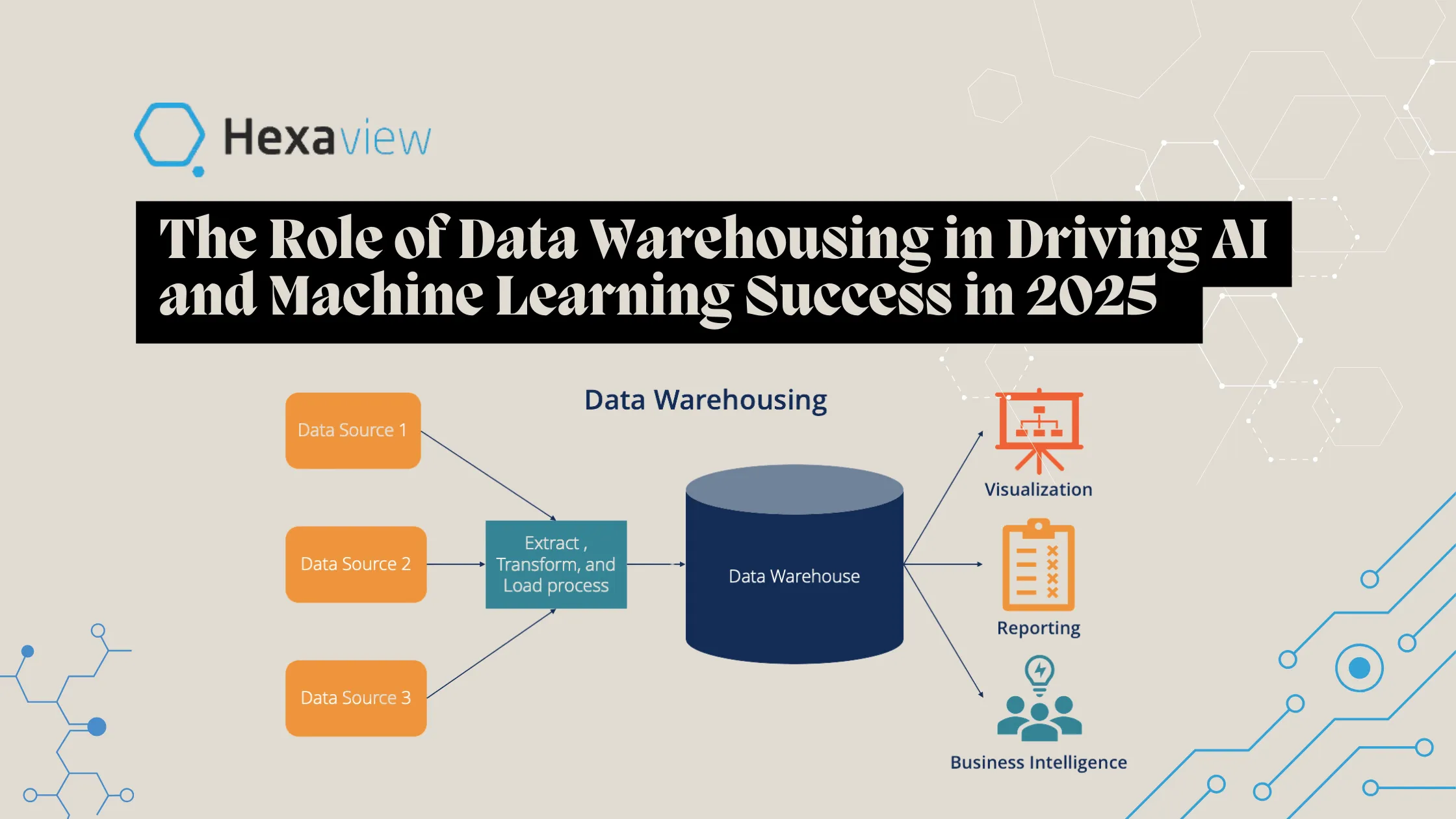The integration of machine learning and data analytics will become the foundational element in 2025 for businesses that are willing to get a competitive edge in the increasingly data-driven world. As artificial intelligence and machine learning in data analytics are constantly gaining prominence, it is important to leverage robust data warehousing solutions to unlock their full potential. A well-designed data warehouse will not only store a wide amount of data but also enable efficient analysis, access, and decision-making, which facilitates the success and growth of AI initiatives.
In this article, we will explore how data warehousing solutions will play an important role in driving the success of AI and machine learning in 2025. We will also highlight the importance of cloud data warehouse solutions, the impact of innovative data warehouse design solutions, and the convergence of data analytics and machine learning.
What is the importance of data warehousing in machine learning and AI?
Data warehousing clearly serves to be the foundation element of data analytics and machine learning. When businesses start collecting more amount of structured and structured data, the ability to store, organize and quickly retrieve information becomes essential to ensure successful AI and machine learning models. As it gets into a centralized repository, it ensures a single accessible location. A data warehouse design solution creates an environment where data scientists will be able to work efficiently with data sets and streamline the process of developing predictive models.
When it comes to machine learning in data analytics, data warehousing plays an important role. Machine learning models heavily rely on massive data sets for training, testing, and validation. Without a maintained and structured data warehouse, it becomes harder to access accurate, clean, and comprehensive data, which hinders the potential of machine learning models.
In the year 2025, AI-driven organizations will require implementing a data warehouse solution that will not only store a huge amount of data but also support the scale and speed required for real-time processing. Cloud data warehouse solutions will also provide scalable storage and allow businesses to process a huge amount of data without any limitations that businesses usually find on traditional on-premise solutions.
Cloud data warehouses and their role in AI and machine learning
Cloud data warehouse solutions have reshaped the data management landscape. With the increasing adoption of cloud computing for different business requirements, there has been an increased reliance on cloud data warehouse solutions, which allow businesses to leverage the power of cloud-based infrastructure for analyzing and storing data.
- Scalability—Cloud data warehouse solutions are known to be highly scalable, as they allow organizations to increase or decrease their storage and processing capability as required. This flexibility is important for AI applications, which often need significant computational power.
- Cost-effectiveness— Cloud-based storage eliminates the need for large upfront infrastructure investments, reducing the overall cost of data storage and management.
- Accessibility—With cloud data warehouse solutions, businesses will be able to access data from everywhere, enabling teams to collaborate in real-time and make effective data-driven decisions.
The speed and flexibility provided by cloud data warehouses can be a game changer for machine learning and data analytics. AI models often require processing a huge amount of data quickly, and the cloud will be able to provide its computational resources to support this requirement. In addition to this, it will allow businesses to experiment with different data warehouse design solutions to customize the infrastructure and meet the specific needs of AI models.
Advanced data warehouse design solutions
In the year 2025, data warehouse design solutions will again play a crucial role in ensuring the effectiveness of machine learning and AI initiatives. The design of the warehouse will directly impact the ability to handle huge data sets, integrate with other AI tools, and support the execution of queries faster. Some of the major design elements that will shape the future of data warehousing include the following.
- Data partitioning—By splitting a huge amount of data states into smaller and manageable parts, data partitioning can enhance query performance and ensure faster processing. This is crucial for real-time AI applications.
- Data integration—Modern-day warehouses need to seamlessly integrate with different sources of data, including customer databases, IoT devices, and social media feeds, which provide a comprehensive data set for AI models.
- Real-time data processing—With the increasing demand for real-time decision-making, data warehouse design solutions will need to support real-time data, injection, and processing. This ensures that AI models are always trained on current data.
Data analytics machine learning to bridge the gap between data and insight
As organizations are increasingly embracing data analytics machine learning, data warehousing seems to become the backbone of organizations as it bridges the gap between actionable insight and raw data. Machine learning models mostly rely on data analytic techniques to process, clean and transform raw data into formats that are ready for model training.
Data warehouses will simplify the process by centralizing and structuring data. They will enable data scientists to focus more on building and refining models instead of spending excessive time preparing and cleaning data. Additionally, integrating data warehousing with machine learning platforms can streamline the entire analytics pipeline from model deployment to data injection.
Future trends of data warehousing for AI, and machine learning
Looking forward to 2025, here are the major trends that will shape the future of data warehousing in the context of machine learning and artificial intelligence.
- Automation and AI in data management—The involvement of AI technology has made data warehousing more intelligent. AI-driven data management tools will be able to automate data cleaning, integration, and transformation, freeing data scientists to focus on developing machine learning models.
- Increased focus on security – As data privacy is a major concern, businesses are now focusing on implementing stronger data governance and security measures. Artificial intelligence and machine learning will be thoroughly leveraged to detect and mitigate any kind of potential security threats.
- Data democratization—Cloud data warehouse solutions will continue to evolve and democratize data access. It will make it easier for non-technical users to engage seamlessly and gain valuable insight. With more people interacting with data, machine learning, and AI models will be designed to make it accessible and provide actionable insights for a broader audience.
Conclusion
As businesses have started embracing AI and machine learning in 2025, data warehousing will be at the forefront to foster success. The integration of cloud data warehouse solutions, advanced data warehouse design solutions, and seamless AI workflow will empower organizations to unlock the potential of data. Focusing more on efficient data storage, faster access to data, and supporting machine learning and data analytics will help companies leverage data as a strategy asset.
Hexaview Technologies provides solutions customized to the unique requirements for modern businesses. Expertise in cloud data warehouses, advanced data architecture, and integration will allow businesses to become well-equipped to face competition and unlock the power of data.



%201.svg)
